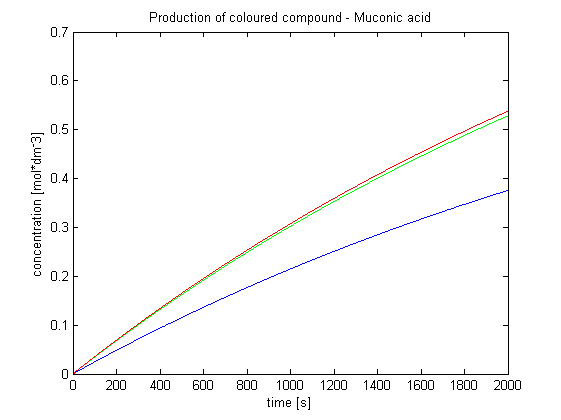Team:Imperial College London/Modelling
From 2010.igem.org
(Difference between revisions)
(Adding results and conclusions) |
(Adding pictures to results and conclusions) |
||
| Line 22: | Line 22: | ||
<li>Conditions for amplification to be effective were determined.</li> | <li>Conditions for amplification to be effective were determined.</li> | ||
</ol> | </ol> | ||
| + | |||
| + | <div ALIGN=CENTER> | ||
| + | {| style="background:#e7e7e7;text-align:center;font-family: helvetica, arial, sans-serif;color:#555555;margin- top:5px;" cellspacing="5"; | ||
| + | |- | ||
| + | |<html> | ||
| + | <img src="http://www.openwetware.org/images/5/51/Cathecol_model_after_cross.png" width="400" alt="Graph showing advantage of 1 ammplification output over simple production" /> | ||
| + | </html> | ||
| + | |- | ||
| + | |Concentration of coloured compound. | ||
| + | |} | ||
| + | </div> | ||
| + | |||
<b style="font-size:12px">Protein Display Model</b><br/> | <b style="font-size:12px">Protein Display Model</b><br/> | ||
<ol> | <ol> | ||
| - | <li>Initial | + | <li>Initial TEV protease concentrations we determined for the optimal activation of the receptor within 1.5 minute after elastases would have come into contact with our cell.</li> |
</ol> | </ol> | ||
| + | <div ALIGN=CENTER> | ||
| + | {| style="background:#e7e7e7;text-align:center;font-family: helvetica, arial, sans-serif;color:#555555;margin- top:5px;" cellspacing="5"; | ||
| + | |- | ||
| + | |<html> | ||
| + | <img src="http://www.openwetware.org/images/d/df/AIP_Threshold_concentration.PNG" width="400" alt="Graph showing when threshold AIP concentration is reached (for different initial TEV concentrations). Notice log-log scale."/> | ||
| + | </html> | ||
| + | |- | ||
| + | |Graph showing when threshold AIP concentration is reached <br/>(for different initial TEV concentrations). Notice log-log scale. | ||
| + | |} | ||
| + | </div> | ||
|} | |} | ||
| Line 74: | Line 96: | ||
Elements of the system: | Elements of the system: | ||
<ol><li>Display protein that consists of cell wall binding domain, linker, AIP (Auto Inducing Peptide)</li> | <ol><li>Display protein that consists of cell wall binding domain, linker, AIP (Auto Inducing Peptide)</li> | ||
| - | <li> | + | <li>Schistosoma elastase (enzyme released by the parasite) cleaves AIP from cell wall binding domain at the linker site. In laboratory we used TEV protease as we could not get handle of Schistosoma elastase.</li> |
<li>ComD receptor is being activated by high enough AIP concentration.</li> | <li>ComD receptor is being activated by high enough AIP concentration.</li> | ||
</ol> | </ol> | ||
Revision as of 14:25, 12 October 2010
| Introduction to modelling |
In the process of designing our construct two major questions arose which could be answered by computer modelling:
|
| Results & Conclusions | ||||
Output Amplification Model
|
| Quick overview of models | ||||||
| Output Amplification Model Goals: This model was mainly developed in order to determine whether simple production is better than 1- or 2-step amplification. Further goals, contained estimation of the speed of modelled response.Elements of the system:
Major assumptions:
The aim of this model is to determine the concentration of Schistosoma elastase or TEV protease that should be added to bacteria to trigger the response. It is also attempted to model how long it takes for the protease or elastase to cleave enough peptides. Elements of the system:
Major assumptions:
|
 "
"








